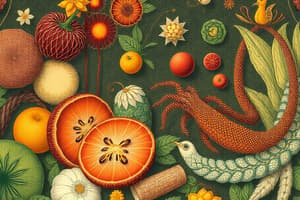Podcast
Questions and Answers
What is the primary purpose of food for living organisms?
What is the primary purpose of food for living organisms?
- To create waste
- To provide energy and nutrients (correct)
- To provide shelter
- To assist in reproduction
Which of the following is NOT a way food is essential for humans?
Which of the following is NOT a way food is essential for humans?
- It promotes growth
- It repairs worn-out tissues
- It provides energy
- It helps in the development of tools (correct)
Organisms that can prepare their own food are known as:
Organisms that can prepare their own food are known as:
- Omnivores
- Autotrophic (correct)
- Heterotrophic
- Herbivores
Heterotrophic organisms are characterized by:
Heterotrophic organisms are characterized by:
Which of the following animals is a herbivore?
Which of the following animals is a herbivore?
Carnivores are animals that:
Carnivores are animals that:
Which of these animals is an omnivore?
Which of these animals is an omnivore?
The main sources of food for humans are:
The main sources of food for humans are:
Which part of the plant is consumed when we eat carrots?
Which part of the plant is consumed when we eat carrots?
Cauliflower and broccoli are examples of which plant part being consumed?
Cauliflower and broccoli are examples of which plant part being consumed?
Which of the following is an example of a fruit that is used as a vegetable?
Which of the following is an example of a fruit that is used as a vegetable?
Edible seeds used as cereals include:
Edible seeds used as cereals include:
Pulses include:
Pulses include:
Oil seeds mentioned in the paragraph include:
Oil seeds mentioned in the paragraph include:
Which of the following is not an example of a nut?
Which of the following is not an example of a nut?
Which plants provide seeds for beverages like coffee and tea?
Which plants provide seeds for beverages like coffee and tea?
Which animal is not typically a source of milk?
Which animal is not typically a source of milk?
Which of these products is made from milk?
Which of these products is made from milk?
Eggs are rich sources of:
Eggs are rich sources of:
Meat is primarily obtained from:
Meat is primarily obtained from:
Honey is obtained from:
Honey is obtained from:
Which statement is true about honey?
Which statement is true about honey?
What is the predominant sugar found in honey?
What is the predominant sugar found in honey?
Which plant part is consumed in the form of spinach and cabbage?
Which plant part is consumed in the form of spinach and cabbage?
What type of food is derived from mustard seeds?
What type of food is derived from mustard seeds?
Which of these is a source of oil?
Which of these is a source of oil?
Which of the following products does not come from an animal source?
Which of the following products does not come from an animal source?
What part of the plant is garlic classified as?
What part of the plant is garlic classified as?
Which of the following is not classified as a spice?
Which of the following is not classified as a spice?
The edible part of the sugarcane plant is:
The edible part of the sugarcane plant is:
Flashcards are hidden until you start studying
Study Notes
Purpose of Food
- Food provides energy and essential nutrients to living organisms.
- It is crucial for growth, repair of tissues, and overall health.
Classification of Organisms
- Autotrophic organisms can produce their own food (e.g., plants).
- Heterotrophic organisms obtain nutrition by consuming other organisms.
Dietary Categories
- Herbivores exclusively eat plants (e.g., cow).
- Carnivores eat only animal flesh (e.g., tiger).
- Omnivores consume both plants and animals (e.g., cat).
Human Food Sources
- Main food sources include plants and animals.
- Different parts of plants provide various types of food, such as:
- Carrots are roots.
- Cauliflower and broccoli are flowers.
Fruits and Vegetables
- Tomatoes are fruits but often used as vegetables.
- Common cereals include rice and wheat, derived from edible seeds.
- Pulses consist of legumes such as grams and peas.
Edible Seeds and Oils
- Oil seeds like sunflower and mustard are important for oil extraction.
- Mustard seeds yield oil, an essential cooking ingredient.
Dairy Products
- Common milk sources include cows, goats, and buffaloes; hens do not produce milk.
- Butter is a product made from milk.
Eggs and Proteins
- Eggs are rich in proteins, offering high nutritional value.
- Meat sources include hens, goats, and sheep.
Honey Production
- Honey is sourced from bees and is known for its medicinal properties.
- The predominant sugar in honey is fructose.
Plant Parts and Their Uses
- Spinach and cabbage consist of leaves.
- Garlic is categorized as a bulb.
- Sugarcane provides edible stems.
Spices and Non-Animal Products
- Common spices include cinnamon, coriander, and pepper; walnuts are not classified as spices.
- Apples are plant-based and do not originate from animals.
Summary of Key Facts
- Understanding food's origins and classifications aids in nutrition and dietary choices.
- Recognizing parts of plants consumed helps in visualizing food sources and their benefits.
Studying That Suits You
Use AI to generate personalized quizzes and flashcards to suit your learning preferences.




